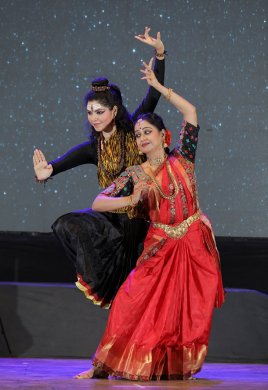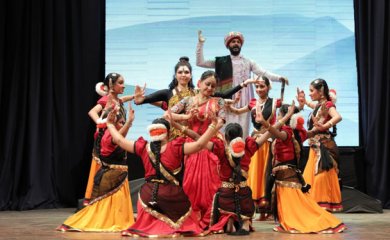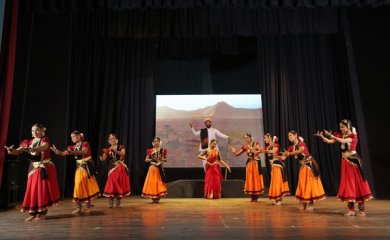
|   |

|   |
The classical and the folk interact in Ayswaria Wariar’s dance drama - Dr. S.D. Desai e-mail: sureshmrudula@gmail.com July 2, 2018 The line Bherkar Bherkar Jogmaya! from Gujarat’s popular Chaarani folk literature as the theme of a classical dancer’s performance on June 23, 2018 at the C.C. Mehta Auditorium in Vadodara was a surprise to the invitees. The opening episode of it set the tone for the dance drama and the surprise gave way to pleasure – the pleasure of watching Ayswaria Wariar’s Mohiniattam with a blend of Bharatanatyam and local folk dance, Carnatic and folk music, folk literature and mythology, feminine grace and masculine power. Nrityodaya’s dance drama based on the Kerala-born dancer-choreographer’s diligent research and broad-based collaboration, the first of its kind in such innovation, is her welcome initiative to creatively interact with and relate to the rich local cultural traditions. Its opening episode, often seen depicted in the Koodiyattam style traditionally, also as part of a play by Bhasa, becomes an engaging preamble to the delightful amalgamation of dance, music, narrative, multi-media and a bit of drama. The Chaarani script is by Pramod Chavan.  There is a sweet quarrel on the Kailasa mountain between Lord Shiva and Goddess Parvati, both having endearing human qualities in their relationship. On noticing Ganga in her husband’s hair, Parvati like any woman on earth, gets jealous and confronts him with questions. He dismisses the first with “It’s only water, dear!” “I see a face there!” she persists, looking at his head from the corner of her eye. “It’s a lotus,” he promptly answers. “And those locks of soft hair?” “Well, they are the bees sucking nectar!” Shiva replies like any resourceful young man. Parvati does not get reconciled. Kainaaz Pardiwala incidentally portrays Shiva in Bharatanatyam tandava and Ayswaria, his consort in Mohiniattam lasya in exhilarating contrasting moods.  It is now that a young handsome Chaaran, traditionally attired in white chudidaar and kediyu, carrying a staff in hand enters. Robustly built Chaarans are a brave cattle grazing community of Kathiawad (Saurashtra), Kutch and the neighbouring Rajasthan. Its women are known for their valour no less than its gallant men. The powerful kalavant koolavant Kathianis can surprise modern educated urban women seeking empowerment. Soon after the Shiva-Parvati shlokas the two gifted dancers visualize, there is the buland full-throated Chaarani recital “tamaara charan-ni raj ame chaarano …” (We are the particles of dust at your feet). The singing and articulate Chaarans were born, accordingly to mythology, of Lord Shiva’s tongue. He asks them to change a sulking Parvati’s belligerent mood. That’s an opportunity for the young Chaaran representative, played by Mehul Suru, an actor, to unfold like a true bard some of the admirable tales of Chaarani women from all the three regions through pre-recorded speech and doohas and ballads eulogizing their historical acts of dauntlessness, daring and pluck – taking even extreme emotional setbacks in life in their stride.  Ayswaria, a dancer known for her taste, strikes a controlled balance between the classical and the folk, the rhythm and visuals, scenes depicting combats and of lyrical togetherness, the maidani singing and the Sopana style music, local colours and those of her native place, live performance and multi-media inputs. To make Shiva-Chaaran communication plausible, the choreographer creates on the screen the limitless universal perspective with images of the galaxy and nature. She seems to have paid attention to the minutest details of the production. Most of the dancers besides the three major characters are carefully groomed teenagers and kids even for a sword-dance. When the kids are joyfully dancing, there is on the screen a video clipping of a white peahen feeding her tiny peachicks!  With a Tillana on Shiva-Parvati reconciliation and Chaaran-Mother Goddess dialogue, the dance drama ends on a celebratory note. A welcome exploration. Now, after the first show, it is time to give the work a smoother flow with finishing touches. The volume of Chaaran’s purported delivery, incidentally, needs to be lowered a bit. Dr. S.D. Desai, a professor of English, has been a Performing Arts Critic for many years. Among the dance journals he has contributed to are Narthaki, Sruti, Nartanam and Attendance. His books have been published by Gujarat Sahitya Academy, Oxford University Press and Rupa. After 30 years with a national English daily, he is now a freelance art writer. |